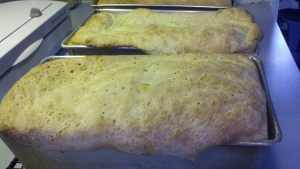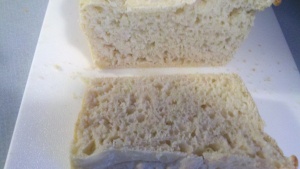Cream cheese: one of the many foods that I, a picky eater, missed out on until adulthood. Now, bagels and cream cheese, cheesecake, stuffed french toast…ahh the delight!
This weekend we attempted cream cheese. It took 24 hours, but it was very much a hands-off experience. Mixing in a mesophilic starter, waiting, pouring into butter muslin, draining, then salting and tasting. It was very easy, but I’m not sure it turned out correctly.
We may have gone wrong with our raw ingredients. Ultra-pasteurized milk won’t make cheese properly. We used it once to make mozzarella, and the cheese tasted fine, but never set into a proper cheese. (It made a yummy cheese dip though.) This recipe called for light cream or half-and-half, but after searching all over town, none could be found that wasn’t ultra-pasteurized. So, we used half heavy cream and half whole milk. Ingenious? Or folly? We can’t really say.
The other place we may have gone wrong was the overnight setting. The milk/starter combination was supposed to set at 72 degrees. We certainly weren’t going to babysit it all night, so we first tried this pot warmer:
 However, it isn’t adjustable, and so it kept the pot a bit too warm. When I checked it the next morning, the cheese when somewhere in the 80 – 90 degree range. So, next time, no pot warmer. Maybe we’ll just pop it into the oven overnight so it can retain its own heat.
However, it isn’t adjustable, and so it kept the pot a bit too warm. When I checked it the next morning, the cheese when somewhere in the 80 – 90 degree range. So, next time, no pot warmer. Maybe we’ll just pop it into the oven overnight so it can retain its own heat.

This is what it looked like – that’s the thermometer probe. It had done quite a bit of thickening overnight.
Next, it was poured  into a colander lined with butter muslin and hung to dry for 12 hours. We changed the muslin once, and could see the change as the cream cheese gave up some of its moisture.
into a colander lined with butter muslin and hung to dry for 12 hours. We changed the muslin once, and could see the change as the cream cheese gave up some of its moisture.

Here’s what we were left with:
Pretty. Creamy. And the flavor? Well, a bit like sour cream. Hm. We even looked up the recipe for sour cream, just in case our substitution, or the overnight temperature, had given us sour cream instead of cream cheese. But no, that doesn’t seem to be the case.
After salting, it tasted a bit more like cream cheese. We flavored some with basil and left the rest plain, with plans of cream cheese brownies next weekend!
Are there any cheese-makers out there who know what went wrong? Or is this how fresh cream cheese is supposed to taste?



 Using the microwave, the mozzarella is heated for a few seconds, then kneaded, heated, kneaded, heated, kneaded…you get the idea. This gives the mozzarella that wonderful stretchiness and stringiness. Before microwaves, the cheese was dipped into the hot whey to heat it up to a workable temperature. What’s a workable temperature? Hot enough that you can only hold the cheese for about 5 seconds without juggling it, and the palms of your hands turn red and radiate heat – a nice feeling for someone with perpetually cold hands!
Using the microwave, the mozzarella is heated for a few seconds, then kneaded, heated, kneaded, heated, kneaded…you get the idea. This gives the mozzarella that wonderful stretchiness and stringiness. Before microwaves, the cheese was dipped into the hot whey to heat it up to a workable temperature. What’s a workable temperature? Hot enough that you can only hold the cheese for about 5 seconds without juggling it, and the palms of your hands turn red and radiate heat – a nice feeling for someone with perpetually cold hands!
 it’s time to shape the cheese. Adam hasn’t created a ball of mozzarella yet that he’s happy with. It’s difficult to get a nice, smooth skin on the cheese, and a perfect sphere seems impossible. I say it’s the taste that counts, but we can keep practicing!
it’s time to shape the cheese. Adam hasn’t created a ball of mozzarella yet that he’s happy with. It’s difficult to get a nice, smooth skin on the cheese, and a perfect sphere seems impossible. I say it’s the taste that counts, but we can keep practicing!



 The recipe calls for proofing the yeast, which produces a wonderful smell.
The recipe calls for proofing the yeast, which produces a wonderful smell.



 :
: And that’s my darling husband’s finger – he’s always gotta be pokin’ the bread!
And that’s my darling husband’s finger – he’s always gotta be pokin’ the bread!